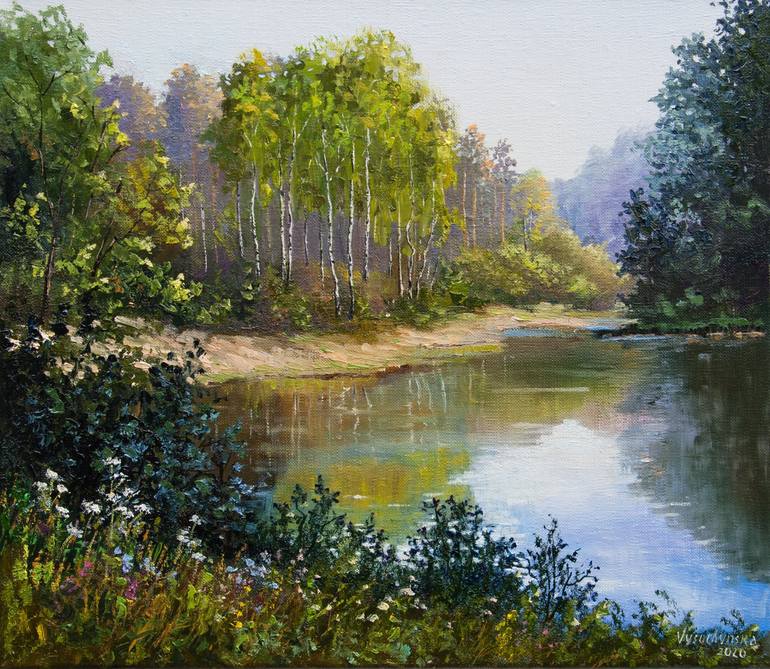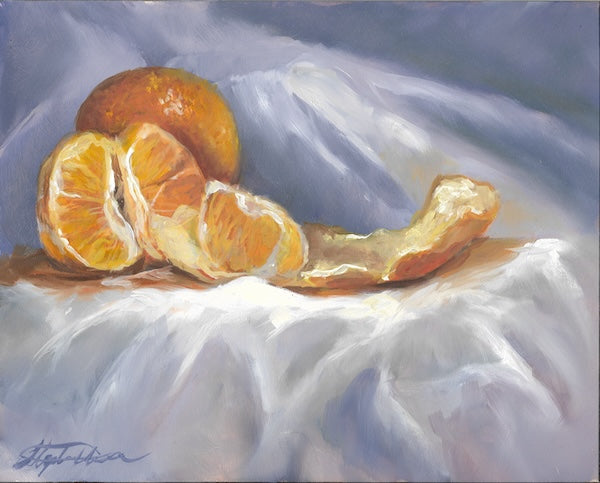The Advantages of Buying Oil Paintings: Why They Are a Timeless Financial investment
The benefits of acquiring oil paints extend beyond simple looks. These art work carry historical importance and social value, making them rewarding additions to any collection. Their distinct textures and methods add to an interesting aesthetic experience. Furthermore, well established musicians usually see their job value in time, providing a prospective financial benefit - oil paintings for sale. As one checks out the multifaceted reasons for buying oil paints, the deeper ramifications of such a selection ended up being increasingly evident
The Aesthetic Charm of Oil Paints
The allure of oil paints hinges on their abundant appearances and dynamic colors, which can change any type of area into an interesting atmosphere. These artworks possess a deepness that captivates audiences, drawing them right into the intricacies of the brushstrokes and the interaction of light and darkness. The shiny coating of oil paint boosts the visual experience, providing life to scenes and subjects in a way that other mediums usually can not attain. Additionally, the selection of styles-- from classical to contemporary-- allows for a varied option that can enhance any type of décor. The emotional vibration conveyed with color selections and techniques includes a layer of connection in between the artwork and the onlooker, making oil paints not just decorative items, but effective expressions of artistic vision.
Historic Importance and Social Worth
Oil paints offer as crucial web links to a creative heritage, showcasing strategies and styles that have developed over centuries. They encapsulate social expressions and identities, mirroring the values and stories of their time. By obtaining these works, people add to the conservation of background and the appreciation of diverse social heritages.
Artistic Heritage Preservation
While lots of may forget the relevance of imaginative heritage, purchasing oil paints plays an essential function in protecting historic and social narratives. These artworks serve as visual documentation of their time, capturing the significance of social worths, customs, and historic events. By acquiring oil paintings, enthusiasts add to the safeguarding of social heritages, ensuring that future generations can learn and value from these creative expressions. Each item mirrors the distinct tale of its creator and the context in which it was made. In addition, the continued appreciation and screen of oil paints in different setups assist to cultivate an understanding of varied creative motions, enriching the social landscape. Spending in oil paintings is not merely a financial choice but an act of cultural stewardship.
Cultural Expression and Identification
Art acts as an effective tool for social expression and identity, reflecting the diverse stories that form societies. Oil paintings, particularly, record the significance of social heritage, highlighting sociopolitical climates and historical contexts. Each brushstroke conveys emotions and stories one-of-a-kind to particular customs, allowing customers to engage with the artist's cultural history. This link promotes a feeling of belonging and understanding among various neighborhoods. Furthermore, oil paintings commonly serve as aesthetic documents of cultural development, showcasing shifts in identity over time. The investment in these art work not only sustains artists but likewise maintains social heritages, making them significant possessions for enthusiasts. Ultimately, oil paints enhance one's recognition for the details of human experience and the rich tapestry of cultural identity.
Gratitude in Worth With Time

The gratitude of oil paints gradually is influenced by numerous elements, consisting of historical worth trends that reflect changing preferences and cultural significance. In addition, the track record of the artist plays an important function in figuring out the art work's market price, commonly raising as the musician gains acknowledgment. Market need fluctuations can even more affect costs, making oil paints a potentially lucrative investment for collection agencies.
Historic Value Patterns
As collection agencies seek to buy concrete properties, the historical value patterns of oil paints reveal an engaging narrative of appreciation over time. Historically, oil paintings have shown a constant higher trajectory in worth, especially for jobs by recognized artists. Economic cycles and market need have actually affected these patterns, with durations of increased rate of interest often resulting in significant price rises. Auction documents often highlight the amazing returns attained by legendary items, additionally strengthening the concept of oil paints as practical long-term financial investments. Furthermore, cultural activities and shifts in enthusiast preferences have actually occasionally spurred unforeseen recognition, disclosing that the art market, while rather uncertain, generally favors top quality oil paintings. Recognizing these historic patterns can lead capitalists in making educated choices.
Musician Credibility Influence
While the credibility of an artist plays a necessary duty in the admiration of oil paintings, it is crucial to identify that this influence can differ considerably based upon a number of variables. Established artists, especially those with a considerable historic or social impact, tend to see their works value a lot more quickly. Alternatively, lesser-known or arising musicians might not experience the exact same level of demand, impacting their art work's worth. Additionally, the artist's capacity to create a regular body of work and preserve importance in the art globe can influence lasting gratitude. Enthusiasts often look for jobs from musicians that are recognized by trusted galleries and organizations, which can additionally boost the worth of an oil painting with time, making artist track record an essential consideration in investment choices.

Market Demand Fluctuations
How do market demand fluctuations influence the admiration of oil paints with time? The value of oil paintings is intrinsically connected to market demand, which can differ based upon financial conditions, trends, and collectors' preferences. In times of financial prosperity, demand commonly climbs, causing increased costs as even more buyers go into the market. Alternatively, throughout financial slumps, need might decrease, causing values to go stale or perhaps decrease. Furthermore, the appeal of specific artists can move, influencing their work's desirability. Ultimately, understanding market demand is necessary for investors, as well-managed collections can appreciate substantially gradually, showing both the talent of the musician and the wider market dynamics. This interaction highlights the significance of calculated buying in oil painting investments.
One-of-a-kind Structures and Strategies
Oil paints mesmerize customers with their unique appearances and strategies, showcasing the artist's mastery over the tool. The thick application of paint, called impasto, develops a three-dimensional effect, welcoming touch and enhancing aesthetic deepness. Musicians usually employ different brush strokes, layering, and glazing approaches to attain luminous shades and detailed details. This convenience enables for abundant contrasts and subtle shifts, making each artwork uniquely expressive. Additionally, the slow drying time of oil paint allows musicians to mix shades perfectly, resulting in vibrant shades and smooth gradients. These techniques contribute to the paint's overall personality, making it an engaging focal point. Each oil paint works as a sign of the imagination and ability integral in standard imaginative methods.
Adaptability in Home Decoration
The one-of-a-kind appearances and methods of oil paints not just showcase artistic skill yet additionally enhance their versatility in home decor. These art work can seamlessly enhance numerous interior styles, from contemporary minimal to standard beauty. Oil paintings act as focal factors, attracting focus and sparking conversation amongst visitors. Their rich colors and deepness can harmonize with different color palettes, making them versatile to altering style fads. Furthermore, the emotional vibration of oil paints can create setting, whether it be warmth in a relaxing living room or vibrancy in a creative work space. By including oil paints, property owners elevate their areas, changing them right into thoughtfully curated atmospheres that mirror individual taste and imaginative recognition. Eventually, oil paintings are an enduring selection for improving home aesthetics.
Link to Prominent Musicians
While several art forms can stimulate appreciation, purchasing oil paintings typically establishes a distinct connection to distinguished musicians throughout background. Owning an oil painting allows collection agencies to engage with the imaginative visions of masters like Van Gogh, Monet, and Rembrandt. Each brushstroke symbolizes the artist's purposes, emotions, and methods, offering insight right into their globe. This link goes beyond time, as each item lugs a narrative that shows the cultural and historic context of its production. Enthusiasts not just get a work of art but also a piece of the artist's legacy. As art lovers discover the tales behind these paints, they get a deeper gratitude for the workmanship and creative activities that more info shaped their development, boosting the value of their investment.
Psychological and Psychological Advantages of Art
Art often works as an effective stimulant for psychological and emotional wellness. The existence of oil paints in a home can evoke a variety of emotions, from peace to inspiration. Their elaborate details and dynamic colors offer audiences a retreat, permitting representation and consideration. Studies suggest that involving with art can lower tension and stress and anxiety, promoting a sense of calmness. Additionally, having initial artwork can produce a personal link, enhancing feelings of pride and pleasure. This psychological bond typically brings about a deeper appreciation of one's surroundings, transforming a house right into a home. Inevitably, the emotional benefits of art prolong past appearances, adding to total psychological health and enhancing life experiences.

Regularly Asked Questions
How Do I Pick the Right Oil Painting for My Area?
Selecting the appropriate oil painting includes considering the area's color design, size, and total visual. One should evaluate personal taste, the paint's psychological effect, and how well it complements existing design before deciding.

What Elements Impact the Value of an Oil Painting?
The worth of an oil painting is affected by factors such as the artist's track record, provenance, historical value, market, rarity, and problem need. Each element adds to general worth and charm amongst collection agencies.
Exactly How Can I Take Care Of and Maintain My Oil Paint?
To care for and preserve an oil paint, one should frequently dirt it with a soft fabric, stay clear of straight sunlight exposure, control moisture levels, and think about specialist cleaning to maintain its vibrancy and integrity.
Exist Particular Musicians Recognized for Their Oil Paintings?
Various musicians are renowned for their oil paints - oil paintings for sale. Significant numbers include Vincent van Gogh, Claude Monet, and Rembrandt, each commemorated for their unique strategies and payments to the art globe through vivid, distinctive oil mediums
Where Can I Purchase Genuine Oil Paints?
Genuine oil paints can be bought from reliable galleries, art fairs, and on the internet platforms focusing on art. Enthusiasts must confirm the credibility and provenance before buying to guarantee a beneficial investment. Historically, oil paintings have demonstrated a regular upward trajectory in value, specifically for jobs by recognized artists. While the credibility of a musician plays a vital function in the appreciation of oil paintings, it is crucial to acknowledge that this effect can differ considerably based on several elements. Oil paintings captivate visitors with their distinct structures and strategies, showcasing the musician's proficiency over the tool. While many art kinds can evoke appreciation, acquiring oil paints typically develops a special link to distinguished musicians throughout background. The worth of an oil painting is influenced by variables such as the musician's track record, provenance, historic relevance, rarity, condition, and market need.